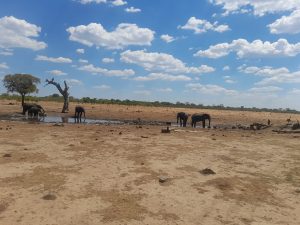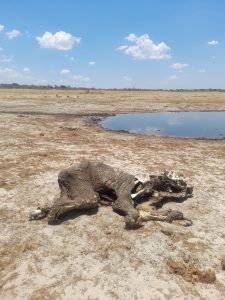

IN A normal season, Lift Sibanda, a villager from Dopota, Zimbabwe, would have planted his fields by November, anticipating a March harvest. This year, however, the outlook is bleak.
Weather forecasts predict delayed rains and potential drought across Southern Africa, with summer rains already five weeks late due to the ongoing El Niño phenomenon.
The effects of the late rains extend beyond human populations, as water and food shortages in Hwange National Park raise the spectre of frequent human-wildlife conflicts.
“Wildlife, especially elephants, usually frequent our fields in search of food and water in March. But this season we haven’t planted anything because the rain hasn’t come, and we fear the worst. The elephants might come even earlier, driven by their desperate search for sustenance,” Sibanda, whose village is located just a few meters from the park, said.

Elephants at a watering hole.
The villager, who has already lost cattle to lions in the past, fears that the lack of rain will cause even more wildlife to move closer to his homestead in search of food.
As animals venture outside protected areas in search of resources, encounters with humans become increasingly likely, leading to crop damage, livestock loss, and even property destruction.
In Hwange National Park – the county’s largest protected area that is home to about 45,000 elephants – dozens of elephants have already died due to lack of water.

The elephant deaths come as global leaders had just gathered to identify and assess climate measures at the UN climate summit in Dubai.
“We have been receiving less rainfall over the years. We are also experiencing high temperatures, up to 43 degrees Celsius. The frequency of droughts has increased over time,” Zimbabwe Parks and Wildlife Management (Zimparks) principal ecologist at Hwange National Park, Daphne Madhlamoto, said.
The El Niño weather conditions are characterised by dry spells and high temperatures. The phenomenon, which amplifies extreme weather events, is a cycle of warming and cooling events that happens along the equator in the Pacific Ocean leading to an increase in sea surface temperatures across the Pacific.
Despite having 104 solar-powered boreholes, park authorities say it isn’t enough and no match for extreme temperatures drying up existing waterholes, forcing wildlife to walk long distances searching for food and water.
Water-dependent mammals like elephants are among the most affected. “Elephants and other wildlife species will face a crisis if the rains don’t come soon,” says Phillip Kuvawoga, Landscape Programme Director of the International Fund for Animal Welfare (IFAW).
“In 2019, over 200 elephants died in Zimbabwe due to severe drought, this phenomenon is recurring.”
The elephant deaths come as global leaders had just gathered to identify and assess climate measures at the UN climate summit in Dubai.
IFAW said its agenda at COP28 advocated for wildlife conservation as a nature-based solution to tackling climate change.
“Wild animals protect the carbon already stored in nature, prevent it from being released into the atmosphere, and help nature soak up and store even more carbon,” said Kuvawoga.
He said the devastating impact of climate change on wildlife and humans calls for an integrated and holistic approach to support climate-resilient landscapes and communities.
“The anticipated deaths of elephants and other species, such as we are seeing in Zimbabwe right now, must be seen as a symptom of deep-seated and complex challenges affecting the region’s natural resources conservation, aggravated by climate change,” Kuvawoga added.
newsdesk@fingaz.co.zw